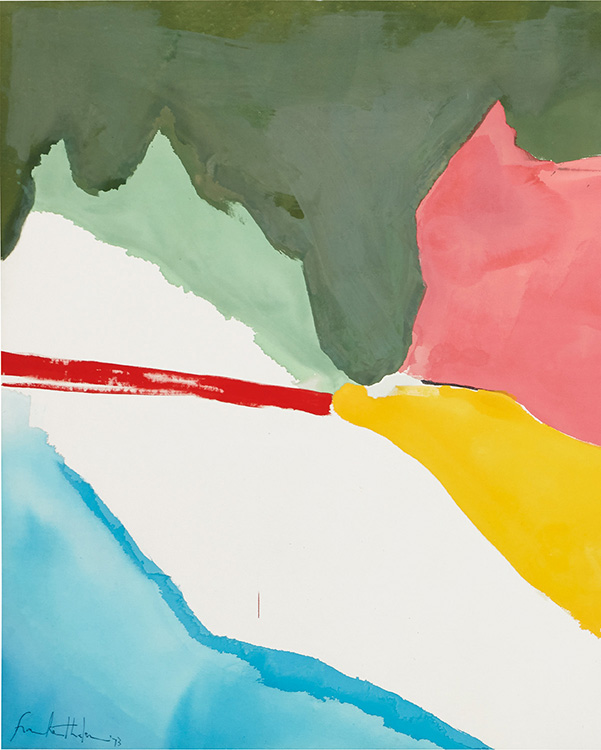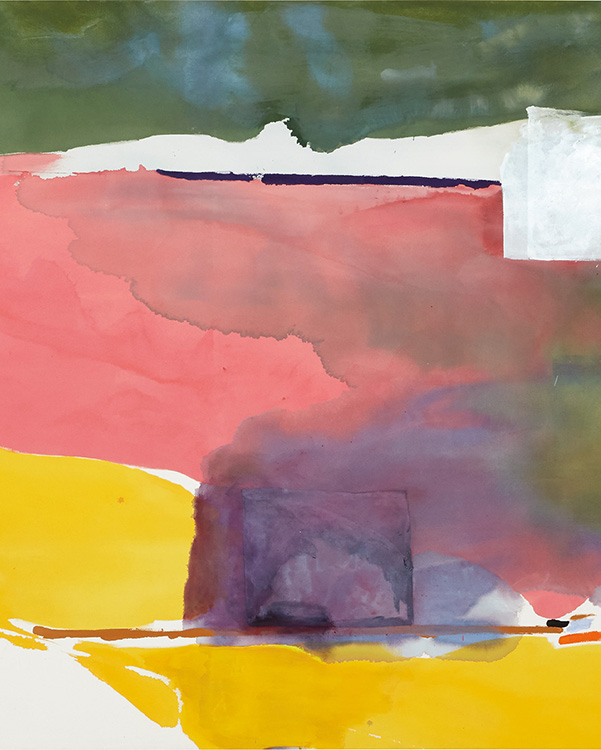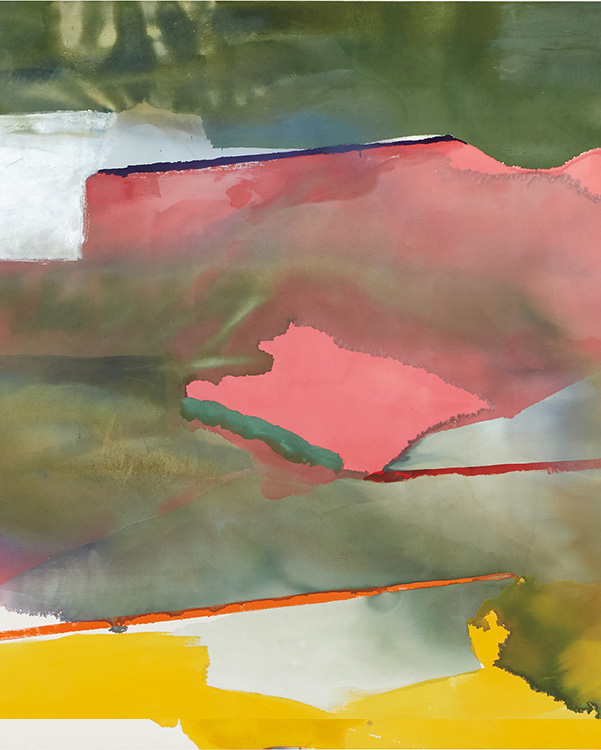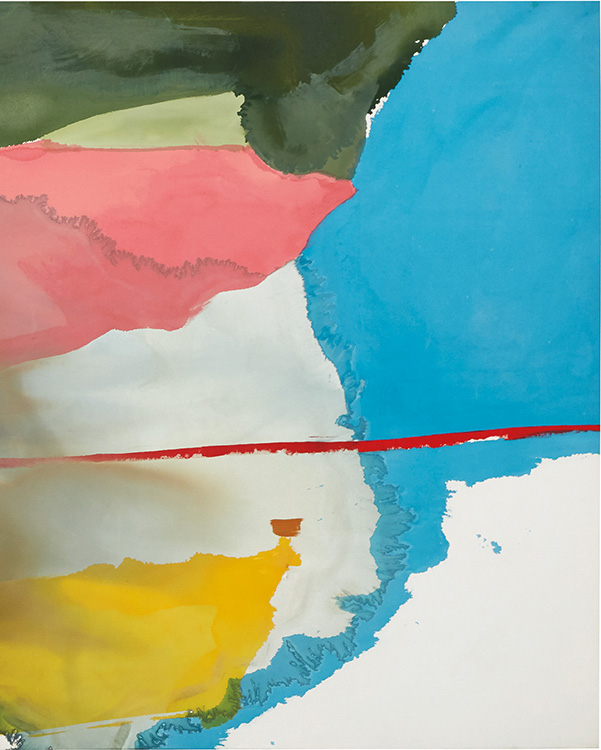HELEN FRANKENTHALER
(1928-2011)
Off White Square, 1973
Acrylic on Canvas
201.9 x 648.3cm
PROVENANCE
Joan and Robert Weiss, California
Ace Gallery, Vancouver
Joan and Robert Weiss, California
EXHIBITIONS
Toronto, David Mirvish Gallery, May 26 – June 16, 1973
Vancouver, Ace Gallery, April – May 17, 1975
Colorado, Denver Art Museum; Washington, D.C., Smithsonian American Art Museum; Nashville, FristCenter for the Visual Arts, Color as Field: American Painting 1950-1975, November 9, 2007 – September21, 2008, pl. 11, p. 118 (illustrated, n.p.)
Williamstown, Clark Art Institute, As in Nature: Helen Frankenthaler Paintings, July 1 – October 9, 2017,p. 72 (illustrated on the frontispiece and pp. 48-49; further illustrated on the exhibition calendar)
New York, 860 Washington Street, Public Art Exhibition from the William Louis Dreyfus Foundation, November 2017 – September 2020
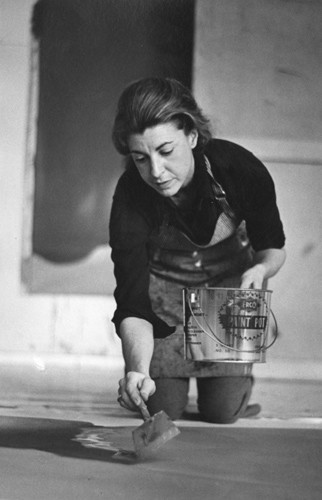
Helen
Frankenthaler
BIOGRAPHY
Helen Frankenthaler was born in New York in 1928. Raised on the Upper East Side of Manhattan in a cultured and progressive family (her father, Alfred Frankenthaler, was a respected New York State Supreme Court judge), Frankenthaler and her sisters were encouraged to study and pursue professional careers. In 1945 she graduated from the Dalton School, where she studied with the Mexican painter Rufino Tamayo. She later studied with Paul Feeley at Bennington College in Vermont, where she absorbed the visual language of Cubism and the formal structures of Old Master painting. After graduating in 1949, and having received a substantial inheritance, she studied privately with Hans Hofmann in Provincetown, Massachusetts, in 1950, and then returned to New York to paint full-time. There, later that same year, while organizing an exhibition at the Jacques Seligmann gallery, she met Clement Greenberg, through whom she would meet some of the central figures of the New York School, including Willem de Kooning, Lee Krasner, Jackson Pollock, and David Smith.
An exponent of Abstract Expressionism, Frankenthaler was focused on analyzing and reproducing natural forms, as is apparent in Mountains and Sea (1952). Measuring approximately 3 meters wide and 2 meters high, Mountains and Sea matches the ambitious scale and gestural handling associated with the New York School, but Frankenthaler’s method of paint application was markedly original: she thinned the oil paint to the consistency of watercolor so that it would soak into and stain the canvas rather than accumulate on its surface. Inspired by Pollock’s drip style, her soak-in technique resulted in fresh, appealing expanses of color that spurred similar experiments by Kenneth Noland and Morris Louis (whom Greenberg took to Frankenthaler’s studio in 1953) and prefigured Color Field painting of the later 1950s and 1960s by Louis, Noland, Jules Olitski, and Frankenthaler herself. Though working in a milieu dominated by male artists, male critics, and a discourse centered on such “masculine” attributes as scale, gesture, and “muscle,” Frankenthaler garnered solo exhibitions at prestigious institutions, regularly received favorable reviews, and gained the respect of her peers.
In 1958 Frankenthaler married Robert Motherwell. At about the same time she began experimenting with the relationship between fine lines and small, sunlike shapes. In the early 1960s she started producing paintings featuring a single stain or blot; she also began to use acrylic paint to create richly colored canvases, such as Cape (Provincetown) (1964). Frankenthaler and Motherwell divorced in 1971, and several years later she bought a second home and studio in Connecticut, where she ventured into the production of welded-steel sculptures, prints, and illustrated books. Further experiments with other mediums led her to design the sets and costumes for a production by England’s Royal Ballet in 1985, though she continued to focus on her painting practice during this period.
Frankenthaler taught at Harvard, Princeton, Yale, and New York universities. Her first solo exhibition took place at the Tibor de Nagy Gallery, New York, in the fall of 1951. Numerous solo exhibitions of her work followed, including retrospectives at the Jewish Museum, New York (1960); Whitney Museum of American Art, New York (1969); Sterling and Francine Clark Art Institute, Williamstown, Massachusetts (1980); Solomon R. Guggenheim Museum, New York (1985); and the Museum of Modern Art, New York (1989). Her many awards include First Prize for Painting at the first Paris Biennial (1959); Joseph E. Temple Gold Medal, Pennsylvania Academy of Fine Arts, Philadelphia (1968); New York City Mayor’s Award of Honor for Arts and Culture (1986); and Distinguished Artist Award for Lifetime Achievement, College Art Association (1994). Frankenthaler passed away in Darien, Connecticut, in 2011.
